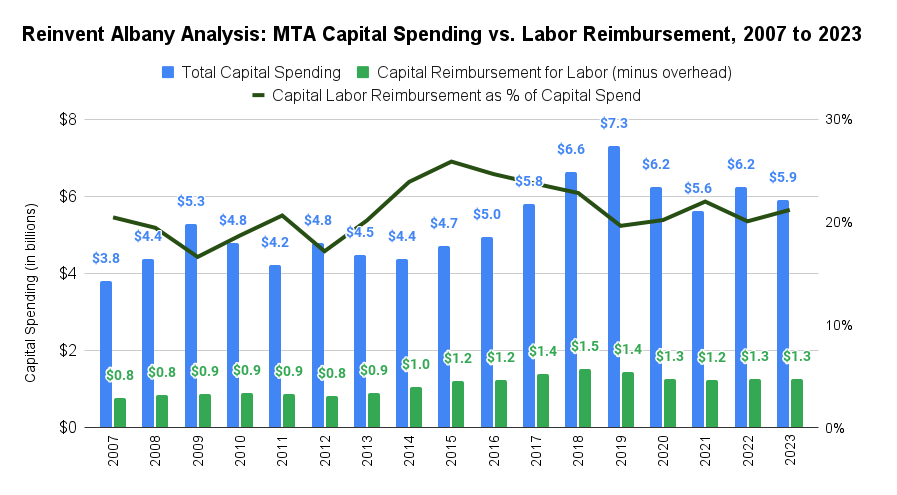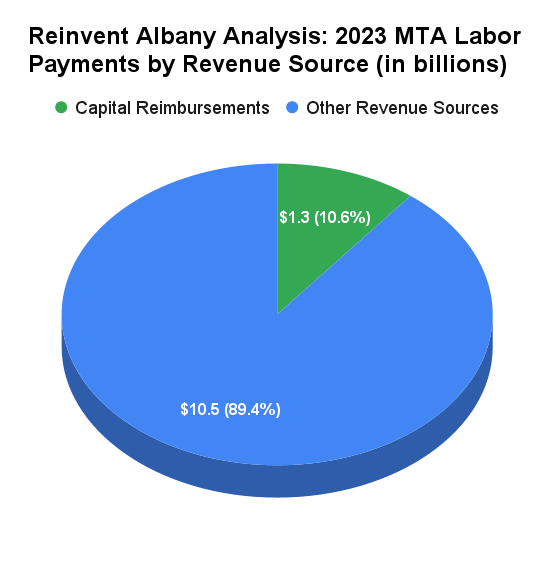Hochul’s Congestion Pricing Cancellation Would Cost MTA Workers $3.2 Billion in Lost Wages
Without $15 billion in new funding to replace congestion pricing, MTA workers – most of whom are members of Transport Workers Union (TWU) Local 100 – would lose up to $3.2 billion in wages. This analysis updates our research from October 2023.
Key Points
- MTA workers doing in-house capital work would get $3.2 billion of the $15 billion congestion pricing is required to raise for the MTA’s 2020-2024 capital plan.
- Over the last 17 years, the MTA’s in-house labor force has gotten $18.8 billion of the $89.5 billion spent on capital projects, like those to be funded by congestion pricing.
- 21% of MTA capital spending has gone to its in-house labor force since 2007.
- In total, 10% of MTA labor costs are covered by capital reimbursements.
- Most of MTA’s in-house capital work is done by New York City Transit employees who are members of TWU Local 100. These workers are paid from capital funds to replace worn subway tracks and switches, provide engineering expertise, and flag construction zones.
The Congestion Pricing-Funded 2020-2024 Capital Plan Would Have Paid Billions 0f Salary and Benefits to TWU and Other MTA Workers
The bar chart below shows spending data from the MTA’s financial plans and audited financials, including the most recent MTA’s February 2024 Financial Plan.1 The blue bars show MTA capital spending has ranged from $4 to $7 billion a year since 2007. The green bars show that more than $1 billion a year in capital funds goes toward the salaries and benefits of the MTA in-house labor force working on capital projects. These payments from capital funds are technically internal “reimbursements” from the MTA’s capital funds to its operating budget.

Capital Reimbursements Cover About 10% of the MTA’s Total Labor Costs
In 2023, capital reimbursements contributed $1.3 billion of the MTA’s $11.8 billion direct labor expenses, as shown in the chart below.
The Simple Math: $3.2 Billion from Congestion Pricing Will Go to MTA Labor
MTA spending data shows an average of 21% of the last 17 years of capital spending went to reimburse the MTA for in-house labor. Congestion pricing will finance $15 billion in MTA capital funds, and 21% of $15 billion = $3.2 billion for MTA in-house workforce salaries and benefits.
Footnotes
1 Reinvent Albany calculated reimbursable labor costs using payroll, overtime, health and welfare, OPEB current payments, pension, and other fringe benefit expenses. Reimbursable overhead expenses were subtracted, as they constitute indirect labor costs for facilities, utilities, and support functions.
Data on labor costs obtained from MTA Financial Plans from 2007 – 2023 using Vol 2, III-2.
Data on capital spending obtained from Consolidated Financial Statements from 2007 – 2022.
Both are available at: https://new.mta.info/transparency/financial-information/financial-and-budget-statements
See also Reinvent Albany’s review of past MTA capital spending here: https://reinventalbany.org/wp-content/uploads/2022/06/Double-Jeopardy_-MTA-Capital-Revenue-and-Spending-June-2022.pdf

